Climate targets and rising sustainability demand necessitate shifting from combustion engines to electric drives. This shift in the automotive industry will extend to other industries like aircraft and commercial vehicle sectors. However, the transition to electric powertrains is challenging, requiring managing multiple technical solutions simultaneously. Managing a diverse product portfolio can be simplified with a suitable modular product structure, aiding companies in transitioning to electric solutions. In this blog article, we will show you how modular structuring of product portfolios can support companies in the transition to electric drive solutions and what is important in the process.
From Combustion Engines to All-Electric Drive Systems
Offering electric drive options has long since become a fixed requirement for manufacturers in the automotive industry. A look at the distribution of drive systems among new registrations shows that the proportion of electric vehicles, for example, in Sweden, rose from 10% to 64% between 2018 and 2022 (source).
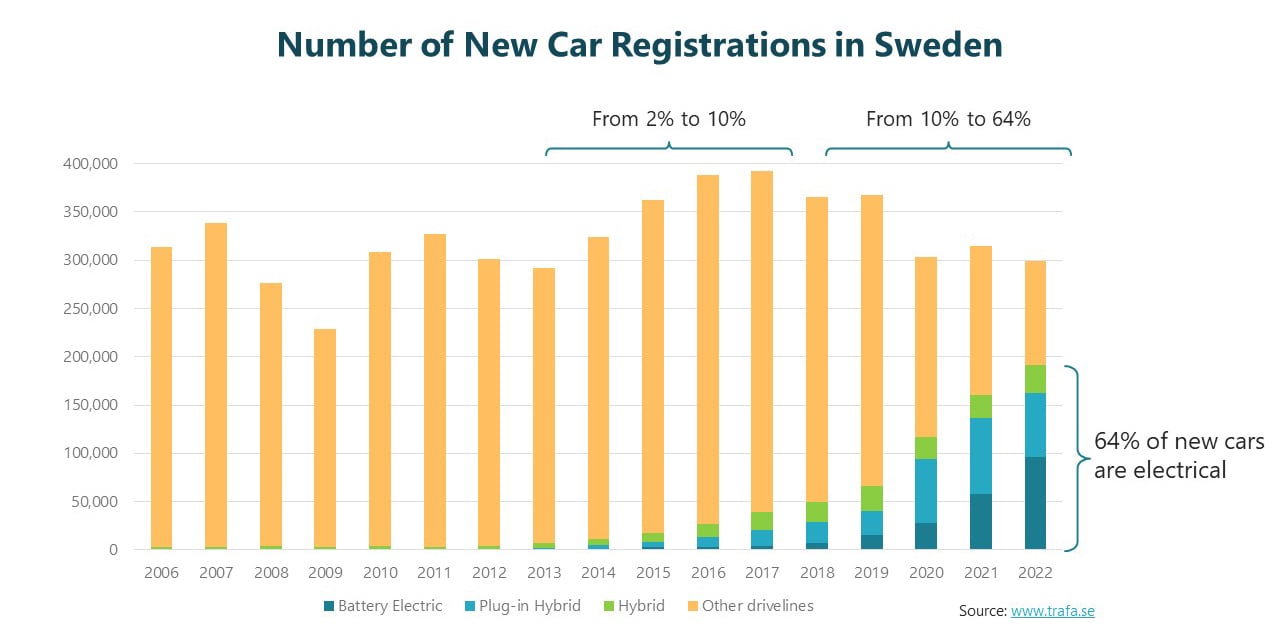
Proportion of electric vehicles in Sweden between 2006 and 2022
While switching to electric drives brings several advantages (e.g., better energy efficiency, reduced greenhouse gas emissions, and general independence from fossil fuels), it also presents manufacturers with new challenges. As established, car manufacturers' expertise and product portfolios are based on internal combustion engines, new competitors have found a niche in the rise of electric drive technologies to gain market share.
The Challenge: Offering Different Drive Technologies Simultaneously
Transitioning to electric drives is a complex task, particularly for established manufacturers. It involves adapting development processes, changing purchasing strategies, and developing new production technologies. However, this transition is not a daunting leap but a series of manageable steps. Transitional solutions, such as hybrid solutions and plug-in hybrid engines, are key to this process, providing a practical and effective path to optimal technical implementation.
The increasing number of drive variants means there are also more product variants in the portfolio, and the company must manage many drive technologies simultaneously during the transition phase. This transition can be illustrated using the example of an excavator that is to be available with a combination of a combustion engine and electrified drives instead of just an internal combustion engine.
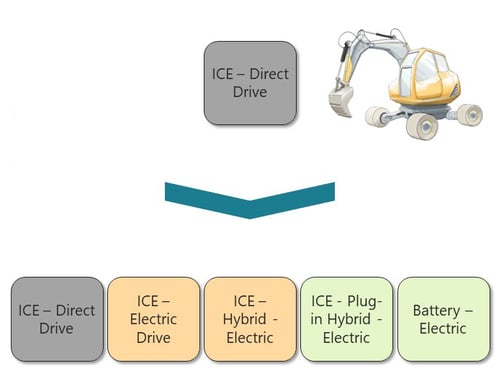 Example: Excavator to be available with combustion engine and electric drive
Example: Excavator to be available with combustion engine and electric drive
The increasing number of product variants means, among other things, that the stock of spare parts required for maintenance is also growing. In addition, manufacturers must be prepared for the transition to all-electric drives will lead to an internal redistribution of sales and production volumes between the individual variants. If the transition is not well planned and capacities are not correctly distributed, this can lead to demand being too low for one variant and too high for another.
The main problem, however, is that a multiplication of drive variants increases the portfolio's technological complexity and the products' technical implementation requirements. Manufacturers must, therefore, aim to design their product portfolio so that the drives can be used across different product generations and versions and that the product structure also allows modules not part of the drivetrain to be reused between different drive technologies. The reusability of the individual drive components across different product variants can be illustrated as follows using the example of the excavator presented above:
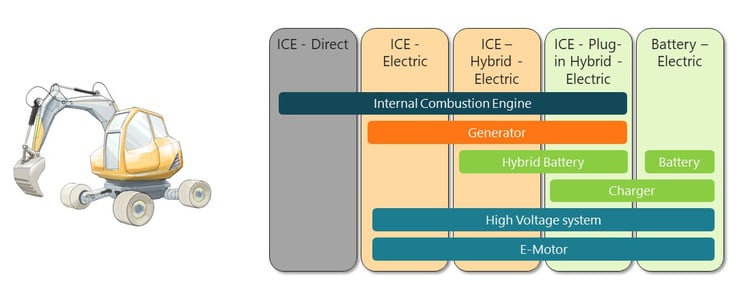
Example: Reusability of drive components across different product variants
We can see that the combustion engine has been designed to be reused for hybrid and plug-in hybrid variants. The generator, battery, and electric motor have also been developed for different electrification stages.
To achieve this reusability, it's crucial to isolate the drive line from the other components. Additionally, defining interfaces that standardize the connection between the drive line and the different product components is a key step. This is where modularization plays a vital role, providing a practical approach to achieving reusability.
The Solution: Modularization and Standardized Interfaces
Basic modularization principles
Modularization, a key strategy in the transition from gasoline and diesel engines to battery electric drives, enables the reuse of subsystems and components across different stages of evolution. Understanding the basic principles of modularization is crucial for grasping its practical application in this context.
Modularization refers to structuring a product portfolio using distinct functional modules that can be combined to create different product variants while adhering to certain combination logic and specifications. The individual function blocks are referred to as modules. Modules can be grouped into module sets that are like modules in many aspects but are configured from the underlying modules’ variants rather than having a fixed list of variants.
Using the previously introduced product portfolio of excavators as an example, the modular structure could be subdivided into the following module sets: frame, cab, hydraulic system, and drive line. Each module set will be available in many different configurations to accommodate a wide product portfolio that comprising three product families ranging from small to medium-sized and large excavators.
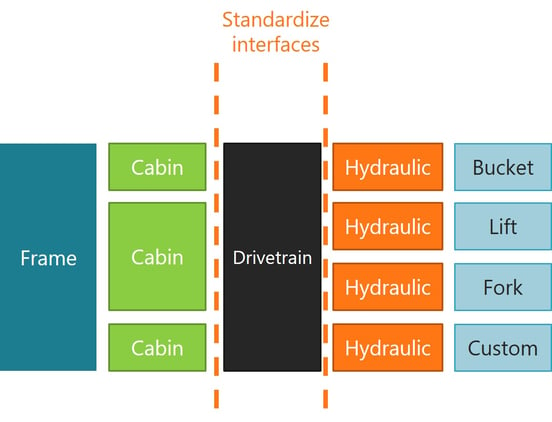
Example: Modularized product structure of an excavator, each box is a schematic configuration of a module set. The drive line module set must fit within the black box.
To ensure that the modules can be flexibly combined, all modular system components must have standardized interfaces. But what exactly are standardized interfaces in this context?
Interface standardization
Interfaces define how the various modules of a modular system are connected or how they fit into the existing installation space in the product. If we look at the example of a modular excavator in which the product variants are to be equipped with different drive types, four different types of interfaces can be distinguished.
- Attachment interfaces that physically connect the modules.
- Communication interfaces, either digital or analog, are used to transmit data to the drive.
- Transfer interfaces, via which force, torque, flow, or current is transmitted.
- Spatial interfaces that specify the available geometric space for the respective module.
All interfaces of the modular system must be wholly and completely documented to ensure that the changes to them are governed during product development or modification of existing product variants.
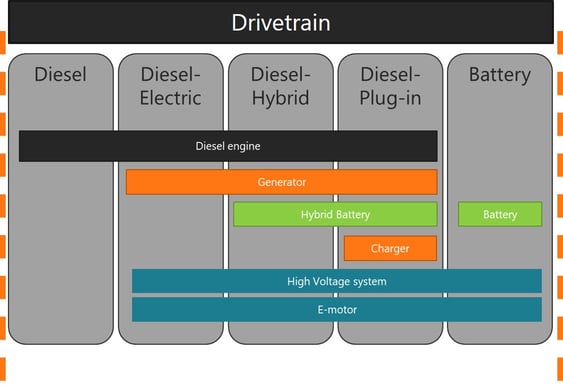
Different types of interfaces
When defining the modules and interfaces, it is important to have the entire product portfolio in mind from the outset. Companies must think carefully about how their product portfolio will develop in the coming years and what technical capabilities they need to create for this in their modular product architecture. By doing this and implementing a structured governance process, change can be controlled and limited to specific modules.
Standardizing the interfaces enables the reuse of module variants across different products and paves the way for the swift integration of new drive line types. This approach sets the stage for us to keep pace with technological advancements and implement new developments in the field of drive lines with ease and efficiency. With all interfaces standardized and carefully documented, the integration of new drive line types into the existing product design becomes a seamless process, minimizing any potential impact on other product areas.
Creating a modular system
By adding new drive technologies, the product portfolio grows steadily over time. Using our excavator product portfolio as an example, the company would eventually have three completely different versions of its product (one with a combustion engine, one with a hybrid drive, and one with a battery-electric drive) if they can’t manage to use the same modular system for the different versions.
To achieve the necessary level of reusability of the individual components and prevent the product structure from having to be completely redesigned and redeveloped for each type of drive, the drive line must be isolated from the other module sets (frame, cab, and hydraulic system) as a separate module set with standardized interfaces. If this is successful, the other module sets can be flexibly reused independently of the drive line used.
At the same time, the individual drive line variants can be seen as a transversal module set that can be installed in different product launches (small, medium, and large). When offering different drive variants and planning the phasing in and out of these variants, companies must proceed carefully to avoid product variants that overlap in delivering on a customer need, which could add complexity to the modular system without added customer value.
Summary
The transition to all-electric drive systems is already well-advanced in the automotive industry, and a similar trend can be expected in other sectors. Manufacturers can meet the resulting challenges by structuring their product portfolios and relying on modularization principles.
Structuring products with independent modules makes it possible to view the drive line as a sub-system (module set) with modules in which the drive technology is encapsulated, in isolation from the rest of the product design and to develop it in line with technological innovations further. The definition of standardized interfaces plays a vital important role here, as they provide the prerequisite for ensuring that components and drive solutions are flexibly interchangeable and can be installed in different product variants.
Further Learning
When defining interfaces, companies must adopt a comprehensive approach from the outset, considering the foreseeable development of the entire product portfolio. We recommend our webinar on Manage Changing Drivetrain Technologies to gain insight into the complete modularization process beyond defining interfaces. In it, Tomas Berg and Björn Rosenquist, Senior Managers at Modular Management, explain in detail how you can successfully manage the transition to battery electric drive lines with the help of modularization.
Let's Connect!
Modular software architecture is a passion of mine and I'm happy to continue the conversation with you. Contact me directly via email below or on my LinkedIn if you'd like to discuss the topic covered or be a sounding board in general around modularity and electric drivetrains.
Tomas Berg
Senior Consultant
tomas.berg@modularmanagement.com
LinkedIn
Björn Rosenquist
Senior Manager
info@modularmanagement.com
LinkedIn





